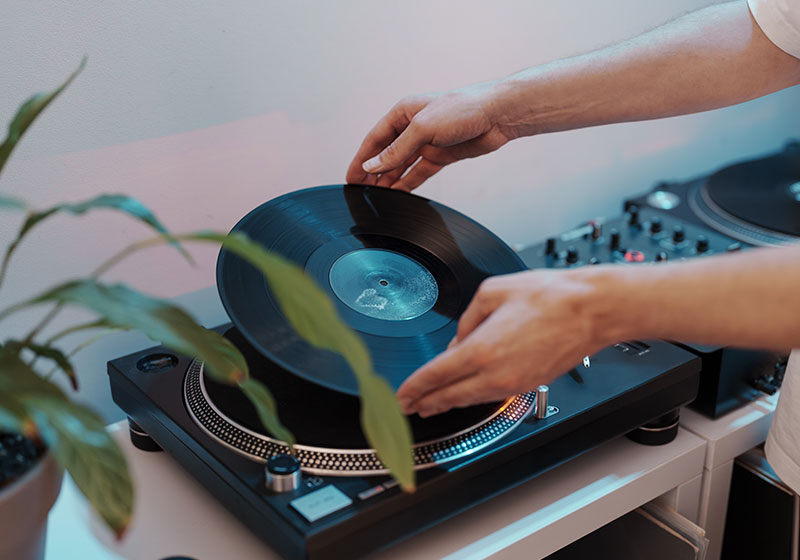Table of Contents
Imagine a record shop. Rows upon rows of shelves filled with records, some clean, some languishing under layers of dust; some fashionable, some hideously outdated; some brightly coloured, others drab and dull. People from all walks of life scrambling to get their hands on the latest release or an impossible-to-find rarity, flicking through the racks and exchanging a knowing glance with their neighbours, with the vinyl they want to buy grasped firmly in their hand.

I’m sure you’ve seen scenes like this in films – A Clockwork Orange and Before Sunrise spring to mind, for example. And there are novels centred on record shops to various degrees too (have you read High Fidelity by Nick Hornby, for example?) In the twentieth century, record shops were iconic places, and vinyl was a cult object, at least until the 1980s, when it began to be replaced by cassettes, CDs, MP3s, and finally streaming.
Vinyl revival: sales second only to streaming
For those nostalgic for physical media, however, all is not lost. If you’ve been following the music market in recent years, you’ll have been amazed to see vinyl enjoying a true renaissance. Instead of disappearing altogether, as you might expect, swept away by the advance of technology, vinyl records have won themselves a niche, yet loyal audience.
And even more surprisingly, the growth in the vinyl market continues to pick up speed.

The so-called ‘vinyl revival‘ began in the mid-2000s, but the phenomenon has really moved up a gear in the last few years. For example, in 2022 and 2023, vinyl sales in the USA exceeded CDs in terms of both numbers and value, making them the top physical medium for listening to music.
Vinyl is therefore the second most popular choice for today’s music listeners after streaming, which accounts for 84% of the music industry’s revenue.
A desire for something tangible: vinyl makes music a physical experience
Recently, one debate has increasingly divided fans of music old and new: which is better, vinyl or digital?
We’re not going to take sides in this thorny issue, nor delve into the technical aspects that differentiate analogue and digital sound. What we will point out, however, is that the return to vinyl stems from the fact that vinyl is a physical object that provides a real experience.
The experience of playing a record involves many of our senses and emotions. Leaving the house to go to a record shop (although of course nowadays many records are also purchased online) and placing a vinyl on the turntable to unplug from modern life, enjoy a moment by yourself or create the right atmosphere in your home are both important rituals for people.

Then there is the visual aspect, which out of professional habit is the area that interests us the most: vinyl is music in object form. A round, colourful object in a large cardboard sleeve, which provides the ideal space for printing images.
Some vinyl covers remain imprinted in our individual and collective subconscious (someone has even created a list of the ten best vinyl covers to own), while others are simply a piece of furniture or something to accompany the listening experience. Either way, great printed record sleeves are apparently one of the top reasons for choosing vinyl.
Vinyl covers: special and limited-edition printed items
The record industry has adapted creatively to the growing niche of vinyl enthusiasts, designing records that are true collector’s items.
And what could be more collectible than limited-edition vinyl? A fashion has now taken hold in the record market for ‘variants’: limited-edition special covers.
Taylor Swift certainly leads the way when it comes to offering her fans special, if not unique, objects. In 2020, she devised nine different covers for the vinyl release of her album Folklore, including different colours of record.

The American singer’s subsequent albums followed suit, with at least three or four different versions for Taylor Swift vinyl fans to choose from (and collect). For the release of 1989, four special-edition records went on sale for just 48 hours.

And other pop stars are not far behind. Beyoncé’s album Cowboy Carter was released in several special vinyl versions, featuring different images and a range of record colours.

Then there are special events, like the release of a successful film, where the record industry wants a piece of the pie. When Barbie was receiving plaudits in cinemas all over the world, both online and bricks-and-mortar record shops stocked a limited-edition vinyl edition of the soundtrack, coloured entirely Barbie pink and electric blue.

And the taste for special vinyl extends far beyond the pop world. The (ahem) record for the most different versions of one vinyl record is probably held by The Rolling Stones: their latest album, Hackney Diamonds, released in 2023, was produced in a frankly ridiculous 43 variants.

And to prove the variety of genres involved in this phenomenon, we’ll end with the recent release by heavy metal musician Ace Frehley, best known for being Kiss’s first guitarist. Ace released several vinyl variants of his album 10,000 Volts, including this one.

How about you? What do you think about vinyl’s comeback? Do you love its unique and collectible covers too? Or perhaps you are considering this format for your next project?

